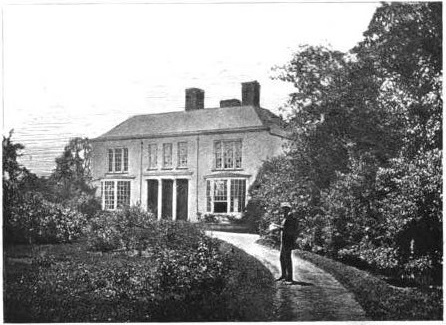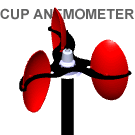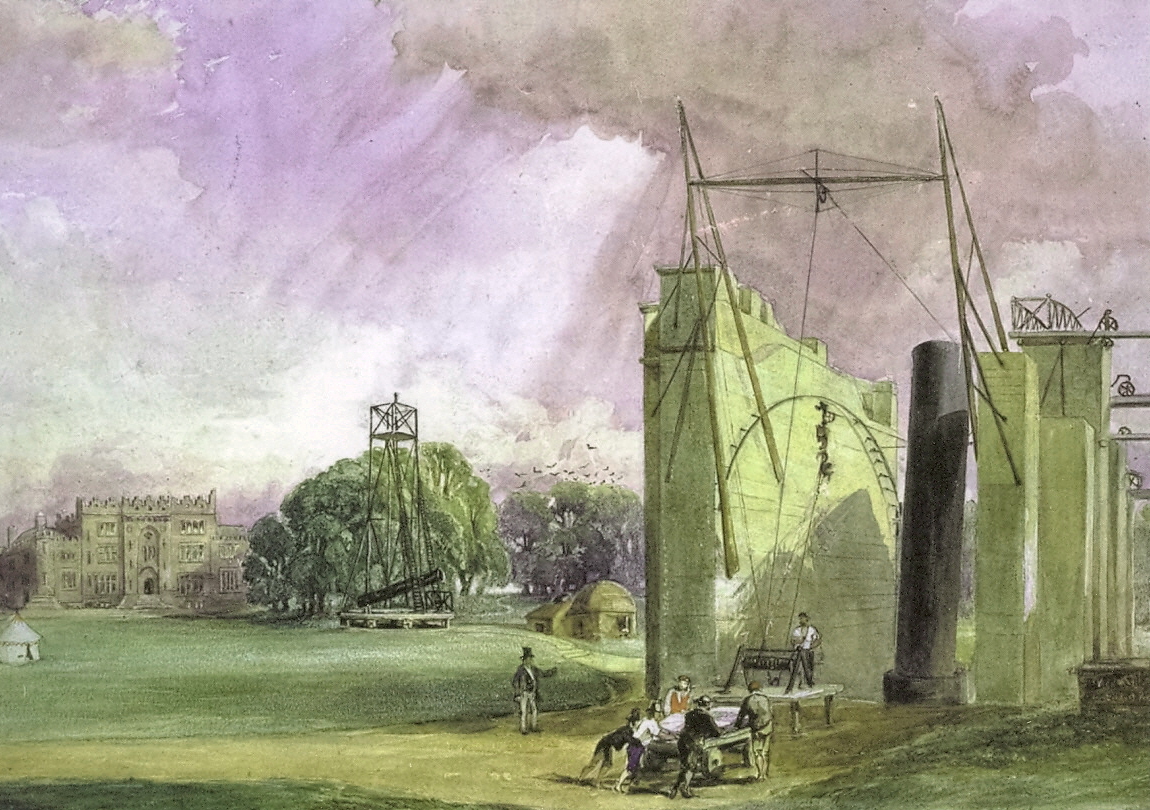|
Thomas Romney Robinson
John Thomas Romney Robinson FRS FRSE (23 April 1792 – 28 February 1882), usually referred to as Thomas Romney Robinson, was a 19th-century Irish astronomer and physicist. He was the longtime director of the Armagh Astronomical Observatory, one of the chief astronomical observatories in the UK of its time. He is remembered as inventor of the 4-cup anemometer. Biography Robinson was born at St Anne's in Dublin, the son of the English portrait painter Thomas Robinson (d. 1810) and his wife, Ruth Buck (d. 1826). He was educated at Belfast Academy then studied Divinity at Trinity College Dublin, where he was elected a Scholar in 1808, graduating BA in 1810 and obtaining a fellowship in 1814, at the age of 22. He was for some years a deputy professor of natural philosophy (physics) at Trinity. Having been also ordained as an Anglican priest while at Trinity, he obtained the church livings of the Anglican Church at Enniskillen and at Carrickmacross in 1824. In 1823, now ag ... [...More Info...] [...Related Items...] OR: [Wikipedia] [Google] [Baidu] |
The Reverend
The Reverend is an style (manner of address), honorific style most often placed before the names of Christian clergy and Minister of religion, ministers. There are sometimes differences in the way the style is used in different countries and church traditions. ''The Reverend'' is correctly called a ''style'' but is often and in some dictionaries called a title, form of address, or title of respect. The style is also sometimes used by leaders in other religions such as Judaism and Buddhism. The term is an anglicisation of the Latin ''reverendus'', the style originally used in Latin documents in medieval Europe. It is the gerundive or future passive participle of the verb ''revereri'' ("to respect; to revere"), meaning "[one who is] to be revered/must be respected". ''The Reverend'' is therefore equivalent to ''The Honourable'' or ''The Venerable''. It is paired with a modifier or noun for some offices in some religious traditions: Lutheran archbishops, Anglican archbishops, and ... [...More Info...] [...Related Items...] OR: [Wikipedia] [Google] [Baidu] |
Enniskillen
Enniskillen ( , from ga, Inis Ceithleann , 'Cethlenn, Ceithlenn's island') is the largest town in County Fermanagh, Northern Ireland. It is in the middle of the county, between the Upper and Lower sections of Lough Erne. It had a population of 13,823 at the United Kingdom census, 2011, 2011 Census. Enniskillen Castle was built in the 15th century as a stronghold of the Maguires, before coming under English control in the early 17th century. The castle and town were expanded during the Plantation of Ulster. It was the seat of local government for the former Fermanagh District Council, and is the county town of Fermanagh. Toponymy The town's name comes from the ga, Inis Ceithleann. This refers to Cethlenn, a figure in Irish mythology who may have been a goddess. Local legend has it that Cethlenn was wounded in battle by an arrow and attempted to swim across the River Erne, which surrounds the island, but she never reached the other side, so the island was named in reference to h ... [...More Info...] [...Related Items...] OR: [Wikipedia] [Google] [Baidu] |
Richard Lovell Edgeworth
Richard Lovell Edgeworth (31 May 1744 – 13 June 1817) was an Anglo-Irish politician, writer and inventor. Biography Edgeworth was born in Pierrepont Street, Bath, England, son of Richard Edgeworth senior, and great-grandson of Sir Salathiel Lovell through his mother, Jane Lovell, granddaughter of Sir Salathiel. The Edgeworth family came to Ireland in the 1580s. Richard was descended from Francis Edgeworth, appointed joint Clerk of the Crown and Hanaper in 1606, who inherited a fortune from his brother Edward Edgeworth, Bishop of Down and Connor. A Trinity College, Dublin and Corpus Christi College, Oxford alumnus, he is credited for creating, among other inventions, a machine to measure the size of a plot of land. He also made strides in developing educational methods. He anticipated the caterpillar track with an invention that he played around with for forty years but that he never successfully developed. He described it as a "cart that carries its own road". He was ... [...More Info...] [...Related Items...] OR: [Wikipedia] [Google] [Baidu] |
Charles Babbage
Charles Babbage (; 26 December 1791 – 18 October 1871) was an English polymath. A mathematician, philosopher, inventor and mechanical engineer, Babbage originated the concept of a digital programmable computer. Babbage is considered by some to be " father of the computer". Babbage is credited with inventing the first mechanical computer, the Difference Engine, that eventually led to more complex electronic designs, though all the essential ideas of modern computers are to be found in Babbage's Analytical Engine, programmed using a principle openly borrowed from the Jacquard loom. Babbage had a broad range of interests in addition to his work on computers covered in his book ''Economy of Manufactures and Machinery''. His varied work in other fields has led him to be described as "pre-eminent" among the many polymaths of his century. Babbage, who died before the complete successful engineering of many of his designs, including his Difference Engine and Analytical Eng ... [...More Info...] [...Related Items...] OR: [Wikipedia] [Google] [Baidu] |
Royal Society
The Royal Society, formally The Royal Society of London for Improving Natural Knowledge, is a learned society and the United Kingdom's national academy of sciences. The society fulfils a number of roles: promoting science and its benefits, recognising excellence in science, supporting outstanding science, providing scientific advice for policy, education and public engagement and fostering international and global co-operation. Founded on 28 November 1660, it was granted a royal charter by King Charles II as The Royal Society and is the oldest continuously existing scientific academy in the world. The society is governed by its Council, which is chaired by the Society's President, according to a set of statutes and standing orders. The members of Council and the President are elected from and by its Fellows, the basic members of the society, who are themselves elected by existing Fellows. , there are about 1,700 fellows, allowed to use the postnominal title FRS (Fellow of the ... [...More Info...] [...Related Items...] OR: [Wikipedia] [Google] [Baidu] |
British Association For The Advancement Of Science
The British Science Association (BSA) is a charity and learned society founded in 1831 to aid in the promotion and development of science. Until 2009 it was known as the British Association for the Advancement of Science (BA). The current Chief Executive is Katherine Mathieson. The BSA's mission is to get more people engaged in the field of science by coordinating, delivering, and overseeing different projects that are suited to achieve these goals. The BSA "envisions a society in which a diverse group of people can learn and apply the sciences in which they learn." and is managed by a professional staff located at their Head Office in the Wellcome Wolfson Building. The BSA offers a wide variety of activities and events that both recognize and encourage people to be involved in science. These include the British Science Festival, British Science Week, the CREST Awards, Huxley Summit, Media Fellowships Scheme, along with regional and local events. History Foundation The Asso ... [...More Info...] [...Related Items...] OR: [Wikipedia] [Google] [Baidu] |
Royal Irish Academy
The Royal Irish Academy (RIA; ga, Acadamh Ríoga na hÉireann), based in Dublin, is an academic body that promotes study in the sciences, humanities and social sciences. It is Ireland's premier List of Irish learned societies, learned society and one its leading List of Irish cultural institutions, cultural institutions. The Academy was established in 1785 and granted a royal charter in 1786. the RIA has around 600 members, regular members being Irish residents elected in recognition of their academic achievements, and Honorary Members similarly qualified but based abroad; a small number of members are elected in recognition of non-academic contributions to society. Until the late 19th century the Royal Irish Academy was the owner of the main national collection of Irish antiquities. It presented its collection of archaeological artefacts and similar items, which included such famous pieces as the Tara Brooch, the Cross of Cong and the Ardagh Chalice to what is now the Na ... [...More Info...] [...Related Items...] OR: [Wikipedia] [Google] [Baidu] |
Cup-anemometer
In meteorology, an anemometer () is a device that measures wind speed and direction. It is a common instrument used in weather stations. The earliest known description of an anemometer was by Italian architect and author Leon Battista Alberti (1404–1472) in 1450. History The anemometer has changed little since its development in the 15th century. Alberti is said to have invented it around 1450. In the ensuing centuries numerous others, including Robert Hooke (1635–1703), developed their own versions, with some mistakenly credited as its inventor. In 1846, John Thomas Romney Robinson (1792–1882) improved the design by using four hemispherical cups and mechanical wheels. In 1926, Canadian meteorologist John Patterson (1872–1956) developed a three-cup anemometer, which was improved by Brevoort and Joiner in 1935. In 1991, Derek Weston added the ability to measure wind direction. In 1994, Andreas Pflitsch developed the sonic anemometer. Velocity anemometers Cup anemometer ... [...More Info...] [...Related Items...] OR: [Wikipedia] [Google] [Baidu] |
Nebulae
A nebula ('cloud' or 'fog' in Latin; pl. nebulae, nebulæ or nebulas) is a distinct luminescent part of interstellar medium, which can consist of ionized, neutral or molecular hydrogen and also cosmic dust. Nebulae are often star-forming regions, such as in the "Pillars of Creation" in the Eagle Nebula. In these regions, the formations of gas, dust, and other materials "clump" together to form denser regions, which attract further matter, and eventually will become dense enough to form stars. The remaining material is then thought to form planets and other planetary system objects. Most nebulae are of vast size; some are hundreds of light-years in diameter. A nebula that is visible to the human eye from Earth would appear larger, but no brighter, from close by. The Orion Nebula, the brightest nebula in the sky and occupying an area twice the angular diameter of the full Moon, can be viewed with the naked eye but was missed by early astronomers. Although denser than the space su ... [...More Info...] [...Related Items...] OR: [Wikipedia] [Google] [Baidu] |
Galaxies
A galaxy is a system of stars, stellar remnants, interstellar gas, dust, dark matter, bound together by gravity. The word is derived from the Greek ' (), literally 'milky', a reference to the Milky Way galaxy that contains the Solar System. Galaxies, averaging an estimated 100 million stars, range in size from dwarfs with less than a hundred million stars, to the largest galaxies known – supergiants with one hundred trillion stars, each orbiting its galaxy's center of mass. Most of the mass in a typical galaxy is in the form of dark matter, with only a few percent of that mass visible in the form of stars and nebulae. Supermassive black holes are a common feature at the centres of galaxies. Galaxies are categorized according to their visual morphology as elliptical, spiral, or irregular. Many are thought to have supermassive black holes at their centers. The Milky Way's central black hole, known as Sagittarius A*, has a mass four million times greater than the Sun. As of ... [...More Info...] [...Related Items...] OR: [Wikipedia] [Google] [Baidu] |
William Parsons, 3rd Earl Of Rosse
William Parsons, 3rd Earl of Rosse (17 June 1800 – 31 October 1867), was an Irish astronomer, naturalist, and engineer. He was president of the Royal Society (UK), the most important association of naturalists in the world in the nineteenth century. He built several giant telescopes. His 72-inch telescope, built in 1845 and colloquially known as the "Leviathan of Parsonstown", was the world's largest telescope, in terms of aperture size, until the early 20th century. From April 1807 until February 1841, he was styled as Baron Oxmantown. Life He was born in York, England, the son of Sir Lawrence Parsons, later 2nd Earl of Rosse, and Alice Lloyd. He was educated at Trinity College Dublin and Magdalen College, Oxford, graduating with first-class honours in mathematics in 1822. He inherited an earldom and a large estate in King's County (now County Offaly) in Ireland when his father, Lawrence, 2nd Earl of Rosse, died in February 1841. Lord Rosse married Mary Field, daughter o ... [...More Info...] [...Related Items...] OR: [Wikipedia] [Google] [Baidu] |
Leviathan Of Parsonstown
Leviathan of Parsonstown, or Rosse six-foot telescope, is a historic reflecting telescope of aperture, which was the largest telescope in the world from 1845 until the construction of the Hooker Telescope in California in 1917. The Rosse six-foot telescope was built by William Parsons, 3rd Earl of Rosse on his estate, Birr Castle, at Parsonstown (now Birr in Ireland). Design and construction Parsons improved the techniques of casting, grinding and polishing large telescope mirrors from speculum metal, and constructed steam-powered grinding machines for parabolic mirrors. His mirror of 1839 was cast in smaller pieces and then fitted together before grinding and polishing; its 1840 successor was cast in a single piece. In 1842, Parsons cast his first mirror, but it took another five casts before he had two ground and polished mirrors. Speculum mirrors tarnished rapidly; with two mirrors, one could be used in the telescope while the other was being re-polished. The telescope ... [...More Info...] [...Related Items...] OR: [Wikipedia] [Google] [Baidu] |

.jpg)

_School_-_Charles_Babbage_(1792–1871)_-_814168_-_National_Trust.jpg)







